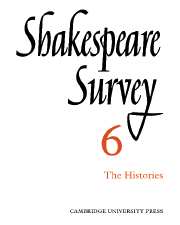Book contents
- Frontmatter
- Shakespeare's History plays: 1900-1951
- The Unity of 2 Henry IV
- Anticipation and Foreboding in Shakespeare’s Early Histories
- Middle-Class Attitudes in Shakespeare’s Histories
- A Reconsideration of Edward III
- On Producing Henry VI
- The Huntington Library
- An Early Elizabethan Playhouse
- Shakespeare Learns the Value of Money: The Dramatist at Work on Timon of Athens
- Shakespeare’s French Fruits
- An Elizabethan Eyewitness of Antony and Cleopatra?
- Othello’s “It is the cause . . .”: An Analysis
- On Translating Hamlet
- Shakespeare in China
- International Notes
- Shakespeare Productions in the United Kingdom: 1951
- Shakespeare’s History Plays - Epic or Drama?
- Festival Shakespeare in the West End
- The Year's Contributions to Shakespearian Study 1 Critical Studies
- 2 Shakespeare’s Life, Times and Stage
- 3 Textual Studies
- Books Received
- Index
- Plate Section
On Translating Hamlet
Published online by Cambridge University Press: 28 March 2007
- Frontmatter
- Shakespeare's History plays: 1900-1951
- The Unity of 2 Henry IV
- Anticipation and Foreboding in Shakespeare’s Early Histories
- Middle-Class Attitudes in Shakespeare’s Histories
- A Reconsideration of Edward III
- On Producing Henry VI
- The Huntington Library
- An Early Elizabethan Playhouse
- Shakespeare Learns the Value of Money: The Dramatist at Work on Timon of Athens
- Shakespeare’s French Fruits
- An Elizabethan Eyewitness of Antony and Cleopatra?
- Othello’s “It is the cause . . .”: An Analysis
- On Translating Hamlet
- Shakespeare in China
- International Notes
- Shakespeare Productions in the United Kingdom: 1951
- Shakespeare’s History Plays - Epic or Drama?
- Festival Shakespeare in the West End
- The Year's Contributions to Shakespearian Study 1 Critical Studies
- 2 Shakespeare’s Life, Times and Stage
- 3 Textual Studies
- Books Received
- Index
- Plate Section
Summary
Every translator is familiar with the difficulties, anxieties, problems and snares of his craft. To begin with, corresponding words in two different languages hardly ever cover the same area of meaning. That is why so-called literal translation is so often unsatisfactory. Plaisir does not mean pleasure; the two words are like two blots of different outline partly covering the same spot on the paper but, for the rest, spreading over different areas. Then again, some things cannot be translated at all because the people who speak the second language, unlike those who speak the first, simply do not say them. An English servant will answer an inquiry at the door: “I am afraid Madam is not in.” That “I am afraid” is utterly incomprehensible in any other language. The French word d’ ailleurs is better dropped when translating French into Spanish. The Spaniard simply does not think that way. There is no word for subir in English; one has to say to go up; but there is no word for up in Spanish.
These are problems of a general nature which beset the translator of any text from one language into another. But over and above them, the task of translating Shakespeare into Spanish verse bristles with problems of its own. The first is that of the language itself. Hamlet is written in the English spoken in London by the wealthy and influential set during the reign of Queen Elizabeth and King James I. A modern translation must appeal to the educated classes of twentieth-century Spain and Spanish America. The translation has therefore to be two-fold: in space, from England to Spain; in time, from 1600 to 1950. A language has to be chosen, in fact, invented, which should not be out of place in either epoch. What is wanted is not precisely that the translation should contain no verbal anachronisms, no words unknown to the Spaniards of 1600; good in itself as a general rule, this practice can in fact be brushed aside in not too glaring cases, without much harm. Rather than philological history or science, taste and art are required, a feeling for style, manner, mood.
- Type
- Chapter
- Information
- Shakespeare Survey , pp. 106 - 111Publisher: Cambridge University PressPrint publication year: 1953

